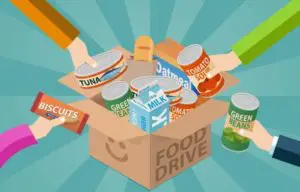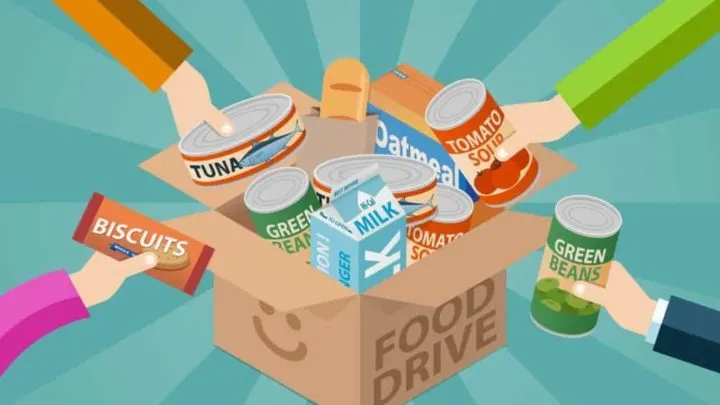Upset about Trump “fixing” our current food stamps program with Harvest Boxes? You should be. It’s a terrible, terrible, terrible idea that will never function as its designers intend. It oversimplifies a complex problem with a one-size-fits-all solution that really fits nobody at all.
The Harvest Box plan calls for boxes of American-made and produced foods to be sent to households who receive $90 or more in SNAP benefits each month. This federal program would let the states determine how the boxes would be delivered. A certain amount of benefits would be deducted for the boxes and the remaining funds would be disbursed onto the EBT cards.
Problem #1 – What about allergies? Dietary restrictions? Ethnic food choices?
The Harvest Box would contain prepackaged, shelf-stable foods like peanut butter, pasta and canned meats. Basically, it provides goods that are readily available at most food banks… but even the people in charge of the food banks think this is a bad idea. Matt Knott, president of the nationwide food bank network Feeding America, said, “We view this as an unworkable solution in search of a problem.”
One of the biggest challenges this program would encounter is the need for customized boxes. You simply can’t ship the same foods to every SNAP household in America. Some households have serious allergies (especially to popular shelf-stable foods like peanut butter). Some households have dietary restrictions, like gluten or dairy intolerance. Some families prefer ethnic food choices that would be expensive, difficult or impractical to include in these boxes.
Problem #2 – What about fresh fruits, vegetables and other healthy food choices?
The Harvest Box would not include any fresh fruit or vegetables. It restricts a low income family’s access to healthy, life-sustaining foods and instead forces those families to choose unhealthier but more affordable shelf-stable, processed and boxed food choices.
This is a problem. As this study in the Diabetes Journal concludes, “people in America who live in the most poverty-dense counties are those most prone to obesity… It has been suggested that individuals who live in impoverished regions have poor access to fresh food… In many poverty-dense regions, people are in hunger and unable to access affordable healthy food.”
Low income families in America need more options for healthy food choices. They need more options for fresh fruit and vegetables. Not less.
Under the current system, food stamps recipients can use their EBT cards at farmer’s markets around the US. Many markets even offer a Double Up Food Bucks program that literally doubles the amount of produce you receive for your money. This invaluable program is usually limited to food stamps users and has helped solve Problem #2 above. With these Harvest Boxes, families who use this program may not be able to continue stocking their kitchens with fresh produce all summer long.
Problem #3 – Those cost-savings estimates are bogus because they ignore most of the costs.
Despite the claims that the Harvest Boxes would save the government money on food stamps, the reality is the exact opposite. In the same reports touting a $130-150 billion savings over 10 years, I also found suspicious statements like “what is in the boxes is also left largely up to the states” and “the logistics of delivery would be largely left to the discretion of the states.” It sounds to me like this very undeveloped plan just shunts the responsibility away from the federal government without a clear plan of what it will cost and who is going to pay for it.
As Jennifer Hatcher, chief public policy officer for the Food Marketing Institute said, ““Perhaps this proposal would save money in one account, but based on our decades of experience in the program, it would increase costs in other areas that would negate any savings.”
In the end, I suspect the Harvest Boxes would be more expensive than the current food stamps setup.
Problem #4 – It will take a whole new bureaucracy to manage this program.
In order to resolve the other four problems, the government will have to establish a new bureaucratic agency to manage the boxes. It will take a number of people to figure out how the boxes work, how they’re filled and how they are distributed to low income residents of all 3,142 counties and county equivalents across the United States. There will be a federal agency. There will be state agencies. There will be laws and regulations and red tape. There will be hundreds of employees. And this is supposed to be cheaper than just continuing the program as it is? I don’t think so.
Problem #5 – Harvest Boxes would destroy the economy of small towns and businesses that rely on EBT funds.
The small businesses that power the economy in severely low income areas could be utterly destroyed without the influx of food stamps funds each month. This article in the Washington Post explains the boom-and-bust economy cycle in the small town of Woonsocket, Rhode Island, where businesses and residents rely on the precious food stamps dollars that keep food on the table and money in the paychecks of the town’s employees.
For towns like Woonsocket, the Harvest Box program could destroy the businesses that provide the jobs that support the families… sending the town spiraling into even more desperate circumstances.

Now here’s the good (and not so good) news…
It’s fairly obvious what an awful idea this is, so it’s been met with widespread disapproval.
Representative Jim McGovern of Massachussets is the ranking Democrat on the committee that oversees federal food assistance programs. He said, “I think it’s dead on arrival — I hope it is — but either way it’s a cruel joke.”
Senator Debbie Stabenow, the ranking Democrat on the agricultural committee, said, “I don’t think there’s really any support for their box plan. And I worry that it’s a distraction from the budget’s proposal to cut SNAP by some 30 percent. That’s the real battle. The dangers are these other proposals to cut benefits. But all anyone is talking about today are the boxes. This isn’t a serious proposal and is clearly meant to be a distraction.”
It’s not too late to have your voice heard. Contact your elected officials and voice your concern about SNAP funding. Specifically, contact your US Senators and Representatives! You can click here for an easy link.

